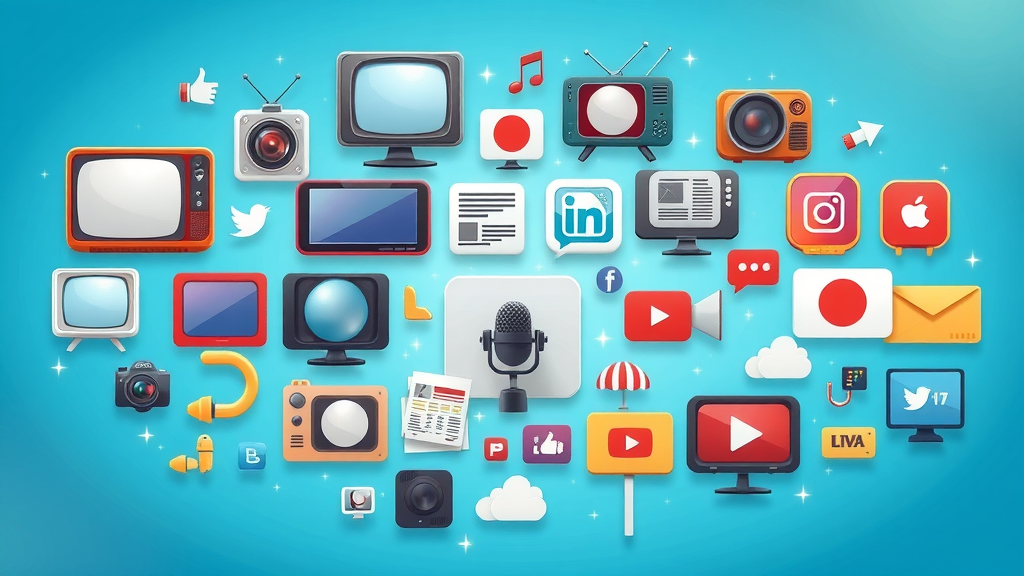Did you know that brands using diverse media channels experience up to 300% greater audience engagement than those relying on just one marketing channel? This eye-opening statistic highlights the undeniable value of using a wide range of media channel examples in modern marketing. In an era where consumers are saturated with information and choices, understanding and implementing different media, marketing, and communication channels is your ticket to breaking through the noise—helping your message land exactly where it matters most.
Unveiling the Power of Media Channel Examples in Modern Marketing
Did you know that brands using diverse media channels see up to 300% greater audience engagement than those who restrict themselves to one marketing channel? Explore how media channel examples can drive results.

Discover why understanding multiple media channels and communication channels is vital for marketing success.
When it comes to modern marketing, the ability to reach and engage your target audience depends on your willingness to explore and harness a range of media channel examples. From traditional TV and radio to cutting-edge digital media and social media platforms, the spectrum of marketing channels is broader than ever. This section will demonstrate the impact of mixing different media ad formats, ensuring your brand remains adaptable and relevant in a fast-moving landscape.
Key Insights: What You'll Learn About Media Channel Examples
The full landscape of media channels, communication channels, and marketing channels
The most effective media channel examples and their ideal use cases
How to select the right communication channel for your marketing goals

Tips for optimizing your marketing strategy using multiple media channels
Understanding Media Channel Examples: Foundations for Success
Define media channel and its significance in comprehensive marketing campaigns
Distinguish between marketing channel, media channels, and communication channels
A media channel refers to the vehicle used to share information and advertising messages with a specific target audience. Its significance in marketing campaigns lies in its ability to reach broad or niche segments effectively. Choosing the right mix of media channels, whether they are digital media channels like social networks or traditional avenues such as television or radio, is crucial for maximizing the impact of your outreach.
Understanding the distinction between a marketing channel , media channel , and communication channel helps marketers align each step of their campaign for success. While a marketing channel involves the path products/services take from business to consumer, a media channel is about message distribution, and communication channels encompass any means by which brands interact with audiences.
"Choosing diverse media channels is the cornerstone of a robust communication strategy."
Integrating well-chosen media channel examples into your marketing strategies can help you fine-tune your messaging for better connection and improved brand awareness.
Why Diverse Media Channels Drive Stronger Communication
How leveraging a variety of communication channels reaches a wider target audience
Statistical advantages of integrating several marketing channels
Real-world business case illustrating multi-channel marketing success
Deploying a combination of communication channels significantly widens your ability to engage with varied customer segments. By layering traditional media such as TV, radio, and print with digital media like social media, email, and display ads, your message is more likely to reach consumers where they are most active. Brands who diversify their media channels see increased message recall, better engagement rates, and stronger conversions compared to those using only one format.
Data suggests that campaigns using four or more marketing channels outperform single-channel efforts by over 300% in terms of engagement and conversion. For instance, a retail brand expanded from television ad campaigns into social networks, influencer marketing, and email marketing, resulting in a measurable uplift in both online and offline sales.
By leveraging multiple media channel examples , organizations create a holistic brand experience which strengthens customer loyalty and fosters continuous interaction throughout the marketing funnel.
Comprehensive List of Media Channel Examples Across Marketing
Traditional media channel examples: TV advertising, radio, print, outdoor ads
Digital media channel examples: social media, email marketing, display ads, search engine ads
Emerging media channels: influencer marketing, podcasts, and in-game ads
Media Channel Examples: Effectiveness and ROI Comparison |
|||
Media Channel |
Reach |
Average ROI |
Best For |
|---|---|---|---|
TV Advertising |
Very High |
150-250% |
Brand Awareness, Mass Markets |
Social Media |
High |
250-400% |
Engagement, Younger Audiences |
Email Marketing |
Medium |
300-420% |
Retention, Targeted Offers |
Digital Display Ads |
High |
100-200% |
Remarketing, Awareness |
Influencer Marketing |
Varies |
400%+ |
Niche Engagement, Trust |
Podcasts |
Medium |
180-280% |
Thought Leadership, Loyalty |
In-Game Ads |
Medium |
120-250% |
Younger, Gaming Audiences |

Each of these media ad formats comes with unique strengths and is suitable for different objectives and audiences. Strategic use of digital media channels , traditional tactics, and emerging formats ensures balanced coverage and leverages the effectiveness of integrated marketing campaigns.
Analyzing Social Media as a Modern Media Channel Example
Role of social networks in multi-channel marketing strategies
Types of social media ads (native ad, video ad, display ad) with real examples
How to align social media choices with your target audience's preferences
Social media stands as a cornerstone in today’s digital media channel landscape. Platforms such as Facebook, Instagram, LinkedIn, and TikTok have transformed the way brands connect with their target audience through tailored ads, two-way conversations, and viral trends. By incorporating various ad formats , including image-based display ads , attention-grabbing video ads , and storytelling native ads , marketers tap into high levels of user engagement and sharing potential.
Example: A fashion brand leverages Instagram stories (native ad) and YouTube video ads to highlight new collections, driving conversations and conversions. The trick is to choose social media platforms that reflect your audience’s interests and behaviors—like LinkedIn for B2B professionals or TikTok for Gen Z consumers. This alignment ensures every marketing message is delivered via the most receptive media channel example.
Integrating social networks into your marketing channel mix creates dynamic engagement loops and keeps your brand top-of-mind with today’s digitally-savvy consumers.
Decoding Television Advertising as a Timeless Communication Channel
Breakdown of TV ad formats: television ad, tv advertising, and enhanced interactive ads
Evolution from traditional TV advertising to cross-platform digital media

Television ad formats have continuously evolved, offering brands new ways to tell their stories. While traditional TV advertising (30- or 60-second commercials) dominates mass-market outreach, interactive and enhanced TV ads now offer on-screen links and QR codes, bridging the gap between TV and digital media. Major brands have seen significant impact by synchronizing their TV ad campaigns with social media and search engine pushes, amplifying brand awareness.
For instance, a tv ad promoting a product launch can be coupled with a social media hashtag campaign, directing viewers to continue engagement online. As viewership shifts from cable to streaming platforms, modern TV ads must be built for cross-platform consumption, ensuring consistent messaging whether the audience is on cable, streaming, or digital apps.
The hybrid nature of television ad integration with digital media platforms maximizes campaign reach, offers measurable outcomes, and maintains TV’s reputation as a powerful media channel example.
Exploring Video Ads: A Dynamic Digital Media Channel Example
Best practices for launching successful video ads across media channels
Integrating video ad strategies with other marketing channels for maximum impact

Video ads have become one of the most engaging digital media channel examples , capturing attention across YouTube, Facebook, Instagram, TikTok, and more. The best practices for video ads include keeping content concise, featuring clear calls-to-action, and ensuring your branding is prominent from the outset. Successful marketing channels blend video with social media and display to drive higher conversion rates.
Brands can enhance impact by sequencing video ad placements with related display ads and email follow-ups. For example, a teased video ad for a product launch can be followed by retargeting display ads and personalized email marketing campaigns to nurture leads and guide prospects down the funnel. Video content also supports native ad formats, blending promotional material organically into user experiences.
Smart integration of video with other media channel examples not only diversifies touchpoints but also builds stronger, more memorable campaigns that resonate with your target audience.
Mastering Email Marketing as a Strategic Media Channel
Role of email marketing as a targeted communication channel
Personalization tips for impactful email marketing campaigns
Case study: Multi-channel marketing with email at the core

Email marketing has maintained its status as one of the most powerful and direct communication channels in modern marketing. It offers precision targeting, allowing brands to nurture customer relationships and drive conversions through personalized content, special offers, and drip campaigns. By segmenting lists and customizing messages, businesses achieve higher open and click-through rates.
For successful results, craft concise subject lines, use dynamic content personalization, and optimize for mobile devices. Case in point: an e-commerce company placed email marketing at the heart of a campaign, complementing it with social media teasers and display ads. The result? A 40% increase in repeat purchases and a sizable boost in customer lifetime value.
Making email marketing the hub of your multi-channel marketing ensures that you can deliver timely, relevant communication alongside other outbound efforts, providing a cohesive experience for your audience.
Display Ads: Visual Powerhouses Among Digital Media Channel Examples
What sets display ads apart in a multi-channel marketing strategy
Examples of successful display ad campaigns across different media channels

Display ads are visual-based advertisements that appear on websites, apps, or social media platforms. What sets them apart is their ability to reinforce brand awareness through eye-catching graphics and strategic placements across multiple digital media channels. With options like static banner ads , animated sequences, and interactive elements, display ad formats offer endless creative possibilities.
Consider a travel brand executing a display ad campaign across popular news sites and social media platforms. Integrating display with email and video ads broadens message frequency and increases the odds of customer action. The key takeaway: visual consistency and tailored audience targeting make display ads indispensable in any multi-channel marketing strategy.
Marketers looking to achieve robust brand awareness and top-of-funnel engagement should consider the strategic placement of display ads as fundamental to their media channel examples.
The Role of Search Engines in Modern Day Media Channels
Benefits of integrating search engine marketing into your media channels plan
SEO and SEM: How they differ as communication channels

Search engine marketing comprises both SEO (Search Engine Optimization) and SEM (Search Engine Marketing), providing marketers with the tools to capture intent-driven traffic. Integrating search engines into your media channel plan means combining organic reach through SEO with targeted paid campaigns via SEM, maximizing visibility for your marketing messages.
SEO acts as a communication channel that earns clicks based on content quality and relevance, while SEM leverages paid placements for immediate exposure. Both strategies are essential components of today’s digital media channels , offering analytical tracking and high ROI when well-executed.
Savvy marketers blend search engine approaches with other media channel examples —think video teasers surfacing in Google results or display ads retargeted on search engine partners—for a seamless and far-reaching marketing campaign.
Emerging Media Channel Examples Changing the Marketing Landscape
Influencer marketing as a compelling new media channel
Podcasts and streaming audio: Targeting audiences with specialized content
In-game advertising as a powerful digital media and marketing channel

The digital age is giving rise to innovative media channel examples such as influencer marketing, podcasts, and in-game advertising. Influencers serve as credible messengers within niche communities, increasing trust and engagement far beyond branded content. Podcasts and streaming audio engage listeners with specialized, long-form content, making them excellent communication channels for extended storytelling and thought leadership.
In-game advertising is rapidly gaining traction, seamlessly blending display ads and sponsored experiences into popular gaming platforms for immersive brand placements. These emerging channels allow for hyper-targeted, highly interactive campaigns that traditional outlets may not match.
By adopting these digital media channel trends, marketers reach hard-to-find audiences and signal their brand’s relevance in the constantly evolving marketing ecosystem.
How to Select the Right Media Channel Examples for Your Target Audience
Step-by-step framework for identifying suitable communication channels
Factors for choosing the right media channel: budget, audience, campaign objectives
"To resonate with your target audience, prioritize communication channels aligned with their habits."
The process of choosing the ideal media channel examples for your campaign starts with thorough research. First, define your target audience and segment by age, behaviors, and media consumption habits. Next, align your campaign objectives—whether boosting brand awareness, generating leads, or facilitating direct sales—with channels most appropriate for those goals.
Consider resource allocation: TV ads and influencer marketing often demand higher budgets, while email and content marketing can be more cost-effective. Evaluate the compatibility of each communication channel with your key messaging and ensure you have the capabilities to maintain quality output across selected channels.
Periodically review analytics, adjust budget distribution, and remain responsive to changing audience preferences. Flexibility and adaptation are your best tools for ensuring lasting success with your integrated marketing channel strategies.
Comparing the Effectiveness of Media Channel Examples
Media Channel Effectiveness Comparison |
|||
Media Channel |
Conversion Rate |
Reach |
Cost-Per-Acquisition |
|---|---|---|---|
TV Ad |
4% |
Very High |
$45-$60 |
Social Media |
12% |
High |
$16-$30 |
Email Marketing |
18% |
Medium |
$10-$20 |
Display Ad |
2.5% |
High |
$28-$40 |
Influencer Marketing |
8% |
Medium |
$25-$50 |

This comparative analysis highlights that while TV ads deliver massive reach, email marketing and social media offer higher conversion rates at a lower cost. Mix and match media channel examples according to your budget and goals for the best returns.
Best Practices for Integrating Multiple Media Channels Into Your Strategy
Tips for seamless marketing channel integration
Examples of effective cross-channel and omnichannel campaigns
The most successful marketing campaigns involve integration across several media channels for a unified message and experience. Start with consistent branding, synchronize content calendars, and use automation tools to keep campaigns coherent and timely. Use cross-channel data to understand consumer journeys and optimize for touchpoints where engagement peaks.
Notable example: A major retailer synchronized its in-store promotions with email notifications, social media blitzes, and app-based push notifications. This approach not only maintained a consistent message but also allowed for highly personalized offers, doubling seasonal sales.
Focus on delivering a seamless journey—so whether someone interacts via a video ad , a display ad , or a sponsored link on a search engine , their path to conversion remains smooth and clear.
Case Studies: Brands Excelling with Diverse Media Channel Examples
Top brands leveraging communication channels for results
Before and after insights: Impact of expanding to new marketing channels
Industry leaders like Nike, Coca-Cola, and Apple illustrate best practices in deploying diverse media channel examples. Nike, for example, expanded its digital footprint by integrating influencer marketing, podcasts, and compelling video ads across social channels. This approach led to a measurable hike in both online engagement and in-store sales.
Coca-Cola’s shift from TV-only campaigns to multi-platform integrations—including mobile apps, social networks, and interactive display ads —helped boost global campaign ROI and cement its brand presence among younger demographics.
These case studies demonstrate that thoughtfully broadening communication channels doesn’t just increase reach—it creates memorable experiences that drive long-term loyalty and revenue growth.
Actionable List: 20 Media Channel Examples to Transform Your Marketing Mix
Print ads
TV ads
Radio
Billboards
Online banners
Native ad
Email marketing
SMS campaigns
Search engine ads
Social networks
Influencer collaborations
Podcasts
Webinars
Streaming video
Display ad
Content marketing
Affiliate marketing
Mobile apps
In-game advertising
Event sponsorship
Experiment with these media channel examples to diversify your strategy, improve your brand awareness, and boost your marketing ROI.
Expert Quotes on the Future of Media Channels
"The evolution of media channels is accelerating. Only the adaptable will thrive." – Industry Thought Leader
"Digital media is not replacing traditional, but expanding the communication ecosystem." – Marketing Analyst
Frequently Asked Questions
What is an example of a media channel?
A media channel example includes television advertising, social media platforms like Facebook, or email marketing channels.
What are the different types of media channels?
Types of media channels cover traditional channels (TV, radio, print), digital channels (social media, search engine ads, email marketing), and emerging channels (podcasts, influencer marketing, in-game advertising).
What are 10 examples of media used?
1. Television 2. Social Media 3. Print 4. Radio 5. Email 6. Podcast 7. Blogs 8. Search engine ads 9. Outdoor advertising 10. Mobile apps
Is TV a media channel?
Yes, TV is a well-established media channel and remains a vital part of comprehensive marketing strategies today.
Key Takeaways for Choosing Impactful Media Channel Examples
Diversify your communication channels for optimal engagement
Tailor media channels to your audience and campaign goals
Stay updated on new digital media and marketing channel trends
Choose your media channel examples with intention, keeping a pulse on audience needs and industry shifts for best results.
Next Steps: Transform Your Strategy With Superior Media Channel Examples
Evaluate your current marketing channels
Implement at least three new media channel examples from this guide
Monitor your results and iterate your media strategy for ongoing improvement
Take action today: audit your channels, diversify your approach, and watch your marketing results soar with the right media channel examples.
To enhance your understanding of diverse media channels and their impact on marketing strategies, consider exploring the following resources:
“6 Advertising Media Channels: Importance & Examples”
This article provides a comprehensive overview of various advertising media channels, including their significance and practical examples. It delves into traditional and digital platforms, offering insights into how each can be effectively utilized in marketing campaigns. Understanding these channels can help you craft a more robust and diversified marketing strategy.
“List of Streaming Media Services”
This resource offers an extensive list of streaming media services, detailing their launch dates, subscriber counts, and available content. It serves as a valuable reference for understanding the landscape of streaming platforms, which are increasingly becoming pivotal in digital marketing strategies. Familiarity with these services can aid in selecting appropriate channels for content distribution and audience engagement.
By exploring these resources, you can gain deeper insights into the various media channels available and how they can be leveraged to transform your marketing efforts.
 Add Row
Add Row  Add
Add 




Write A Comment